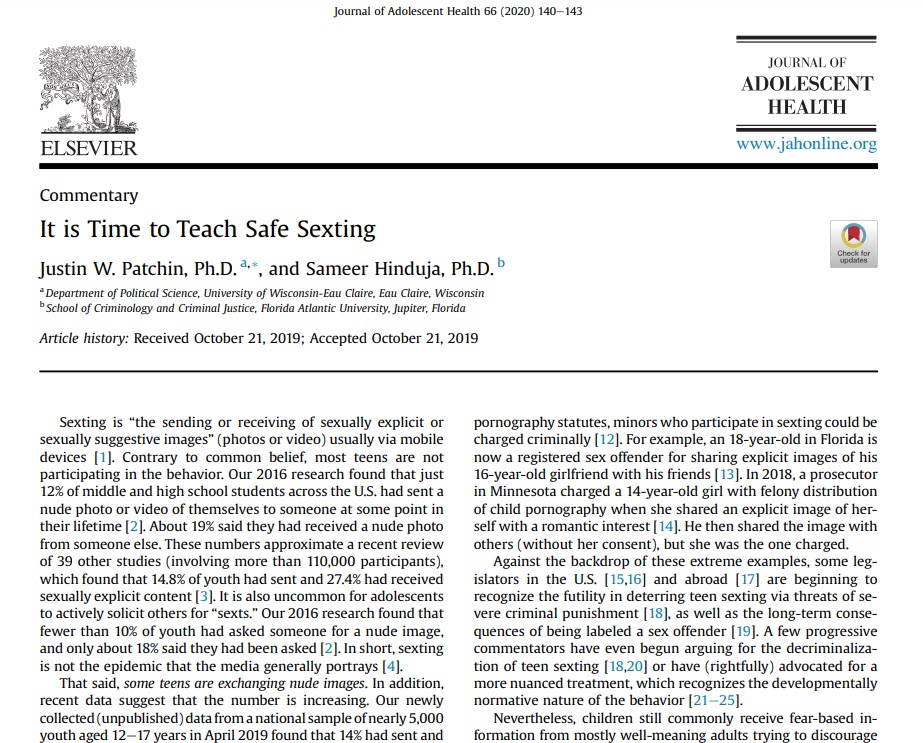
It’s 2020. And it’s about time we rethink our approach to teen sexting. Justin and I wrote an piece that was just published in the Journal of Adolescent Health (currently free to download!) arguing that it is time to take a more thoughtful and comprehensive approach to sexting, by supplementing abstinence messages with information to reduce harm should youth people choose to participate. This isn’t about encouraging kids to sext, but about minimizing the worst of the potential problems that could result. Deterrence-based messaging has failed to curtail the sexting problem and, frankly, something more needs to be done. While I encourage everyone to read and discuss the paper – which includes specific strategies for minimizing harm associated with sexting – below I discuss some of the issues that prompted its writing.

Teen Sexting is a Problem
Sexting continues to be a topic of major concern among parents, educators, and youth professionals responsible for teaching the current generation of adolescents to use technology with wisdom and discretion. We define sexting as “the sending or receiving of sexually explicit or sexually suggestive images” (photos or video) usually via mobile devices.” Understandably, most adults don’t want kids to be taking sexy topless shots or “dick pics” and sending them around to each other. There are many good reasons for this.
First, according to the formal letter of the law, nudes could be classified as child pornography if the depicted individual is under the age of 18. The sender and recipient can be charged criminally if caught under those laws which were meant to apply to adults who exploited children.
Second, sharing explicit images counters historically ensconced thinking about how children should behave, and what behaviors they should abstain from until they gain more emotional maturity and perspective (Boyer & Byrnes, 2009).
Third, sexting can contribute to the objectification and sexualization of the youth involved, and can result in further exploitation via sextortion, revenge porn, predators, cyberbullying, blackmail, threats, humiliation, and a destroyed reputation. And according to the research, these outcomes can also contribute to numerous negative emotional, psychological, behavioral, and physiological consequences (Gámez-Guadix & De Santisteban, 2018; Grabe & Hyde, 2009; Tiggemann & Slater, 2015; Vasquez, Osinnowo, Pina, Ball, & Bell, 2017).
“In contrast to previous generations, where the flashing of a classmate might have had only momentary consequence, new technology greatly enhances the likelihood that such indiscretions will be permanently recorded and disseminated to large audiences.” (Eraker, 2010:563; Gold, 2017)
When we think about it, the risks are very evident. Personally, I don’t want kids sending nudes to each other – even if they are in a committed relationship – because relationships in middle and high school rarely last. And based on my observations and conversations with youth, when breakups happen, they are typically not amicable. Rather, they often end with a lot of drama and pain. As a result of the anger and disappointment, private pictures and videos are more vulnerable to sharing outside of their intended audience.
From what I can tell, kids who sext just don’t feel the weight of the possible negative outcomes. They hear us preaching to them, and they’ve also seen some of the tragic headlines. But some seem to have an invincibility complex and don’t think that anything bad is going to happen to “them” (Dunkels, Frånberg, & Hällgren, 2011; Livingstone, 2008). Maybe to others, but not them.
Anecdotally, many teens who sext tell me that sexting is a harmless, normative behavior that is done for various reasons: foreplay, experimentation, a prelude to hooking up, to increase intimacy, as a form of sexual expression, because that’s what you do when you love someone else, because they’re proud of their body and it’s their right to show it off, because it’s exciting and enjoyable.
“This is awesome, risky, sexy, fun, flirty, intimate, and the chances are that nothing bad will happen.”
“This is my body, I should be able to do whatever with it.”
“I work hard on having a nice body and I should be able to show it off if I feel like it.”
Given the desire in many teens to be intimate with their partners and the potential consequences of doing so using technology, along with the so far ineffective efforts to stem participation in these behaviors, it is time to reconsider our approach to teen sexting.

A New Paradigmatic Approach – Harm Reduction Instead of Risk Reduction
Justin and I have been discussing the best ways to address sexting behaviors among youth for many years, including whether there should be some form of safe sexting curriculum, to teach youth about the consequences of participation, and how to mitigate those. In general, we believe that just like with the evolution of sex education in the United States, we need to move from the exclusive goal of risk reduction (Markham et al., 2012) to the inclusive approach of harm reduction (Leslie, Society, & Committee, 2008). In case these terms are unfamiliar, allow me to briefly summarize what I mean.
Risk reduction focuses on the possible vulnerabilities and dangers that youth might face, and attempts to eliminate them if at all possible. It’s not just an approach, but also a worldview that reflects the notion that we need to save kids from themselves and from a host of potential evils that surround them. The problem with this mentality, though, is that it promotes moral panic and fear mongering, as well as rule-based restrictive and punitive controls on their life. From a risk reduction perspective, some experts have preferred that kids rarely play away from vigilant supervision for fear of being kidnapped and sexually assaulted by pedophiles (Kalish, Banco, Burke, & Lapidus, 2010). Others have railed against social media apps, gaming platforms, and online connectivity in general for the same reasons (Sher, 2010)– overemphasizing the possibility of stranger danger and undervaluing the inherent knowledge and savvy of youth to implement some measure of safety precautions themselves (Nolan, Raynes-Goldie, & McBride, 2011; Sullivan, 2008; Todd, 2015). These perspectives seem counterproductive at best and serves as an axe to the base of candid dialogue between adults and youth. Bringing the conversation back to sexting, a risk reduction approach means that we spend all of our time and energy demanding that youth never send intimate pictures to anyone while creating a police state of sorts to try to ensure it doesn’t happen (e.g., monitoring, spyware, etc.)
Harm reduction, conversely, begins with the assumption that some youth are going to engage in certain risky behaviors, and with that in mind informs policies and practices designed to reduce the negatives that may occur. Allow me to provide you with a real-world example to make this clearer before circling back to sexting. We know that some teens drink and get drunk sometimes, and some use recreational or illicit drugs (YRBS, 2017a, 2017b) – to have a good time, to medicate or numb themselves, or for other reasons. Risk reduction generally involves demonizing alcohol and drugs, focusing on criminal penalties, and employing scare tactics to get kids to stay far, far away from those substances. Harm reduction conveys the reality of consequences but also provides counseling and guidance about preventing major fallout during and after drinking or using drugs. For example, a recommendation might be to give someone your car keys before you start drinking and have a designated driver, or to sleep it off where you are. Or reminders to keep eating and stay hydrated while drinking. Or providing knowledge related to what leads to overdosing and the bad mixing of chemicals.
To be sure, some kids are not going to heed the advice and do some experimenting on their own. If that is going to happen, it seems critically essential to share advice that can preempt the most serious harms from occurring (e.g. overdosing, drunk driving, alcohol poisoning, etc.). Education not only involves describing dangers and attempting to deter immature and unwise choices, but also how to make sure the backlash from those choices is not fatal.
Safe Sex and Safe Sexting
I understand that the thought of educating kids about safe sexting may make you cringe. But the same emotional reaction happened back when safe sex education was first introduced. Two generations ago in conservative America, many adults and legislators promoted abstinence-only policies and programming when it came to sex education in primary and secondary schools (Santelli et al., 2017). They believed that teaching about condoms and safer sex practices would tacitly encourage the onset of participation from those not normally so inclined. Public opinion consistently suggested strong support for abstinence as a “behavioral goal for adolescents” (Santelli et al., 2006). In fact, more than two billion tax dollars were spent on abstinence-only, wait-until-marriage education in the US over the last 25 years (Boyer, 2018). It took the HIV epidemic in the mid-1980s (Williams, 2011) to bring more people into the camp of safe-sex education – and now it is commonly acknowledged that this approach – though very progressive at the time – has done a world of good in preventing STDs and unwanted pregnancies (Fonner, Armstrong, Kennedy, O’Reilly, & Sweat, 2014; Stanger-Hall & Hall, 2011).
As the years have gone on, research has examined the effect of sex education on teen pregnancies and sexually transmitted infections and concluded that “there does not exist any strong evidence that any abstinence program delays the initiation of sex, hastens the return to abstinence, or reduces the number of sexual partners” (Kirby, 2007:15; see also Hauser, 2004; Landry, Kaeser, & Richards, 1999; Trenholm et al., 2007). This research has finally begun to affect public policy, as former President Barack Obama eliminated a $10 million per year grant in 2016 from the Department of Health and Human Services that supported abstinence-only programs.
Some type of education, though, does work (Clemmitt, 2010; Kirby, 2001). Studies have consistently shown that comprehensive sex education (which includes information about safe sex, not just abstinence) results in fewer teens having sex and getting pregnant, and a delay in the initiation of sexual activity (Kirby, 2008; Kirby, Laris, & Rolleri, 2007; Kohler, Manhart, & Lafferty, 2008; Mueller, Gavin, & Kulkarni, 2008). Overall, the number of teens having sex has decreased significantly over the last generation. According to the CDC’s 2017 Youth Risk Behavior Surveillance, 39.5% of high school students report having had sex. In 1991, that number was 54%. Moreover, the teen pregnancy rate is at a record low (20.3 births per 1,000 females aged 15-19 in 2016, compared to 62.1 per 1,000 in 1991). These are all positive trends, occurring at a time when more comprehensive sex education has become more common in schools.
That said, sexting behaviors do not seem to be slowing. Our 2016 research found that 12% of middle and high school students across the U.S. had sent a nude photo or video of themselves to someone at some point in their lifetime (Patchin & Hinduja, 2019). About 19% said they had received a nude photo from someone else. Our newly collected (unpublished) data from a national sample of nearly 5,000 youth aged 12–17 years in April 2019 found that 14% had sent and 23% had received sexually explicit images. These figures represent an increase of 13% for sending and 22% for receiving from what was found in 2016. So while some indicators of teen sexual behavior are trending in the right direction, sexting is not. As such, something new needs to be done.

Strategies for Safe Sexting
In our piece that appears in this month’s issue of the Journal of Adolescent Health, we articulate 10 strategies to reduce harm in sexting situations. Here are some examples that can be shared with adolescents in certain formal (educational, therapeutic) or informal (familial) contexts after weighing their developmental and sexual maturity.
1. If someone sends you a sext, do not send it to—or show—anyone else. This could be considered non-consensual sharing of pornography, and there are laws prohibiting it and which outline serious penalties (especially if the image portrays a minor) (Burris, 2014; Krieger, 2017; Waldman, 2016).
2. If you send someone a sext, make sure you know and fully trust them. “Catfishing” – where someone sets up a fictitious profile or pretends to be someone else to lure you into a fraudulent romantic relationship (and, often, to send sexts) – happens more often than you think (Hartney, 2018; Smith, Smith, & Blazka, 2017). You can, of course, never really know if they will share it with others or post it online, but do not send photos or video to people you do not know well.
3. Do not send images to someone who you are not certain would like to see it (make sure you receive textual consent that they are interested). Sending unsolicited explicit images to others could also lead to criminal charges.
4. Consider boudoir pictures. Boudoir is a genre of photography that involves suggestion rather than explicitness. Instead of nudes, send photos that strategically cover the most private of private parts. They can still be intimate and flirty, but lack the obvious nudity that could get you in trouble.
5. Never include your face. Of course, this is so that images are not immediately identifiable as yours, but also because certain social media sites have sophisticated facial recognition algorithms that automatically tag you in any pictures you would want to stay private.
Check out the full list in our paper.
Final Thoughts On The Safe Sexting Approach
Despite efforts to dissuade youth from sharing intimate images, some teens continue to participate in sexting. Adopting a harm reduction framework to educate those inclined to sext will help minimize the worst of the possible outcomes that could occur. Such a philosophy should include strategies for youth to utilize to reduce the likelihood that their images can be directly linked to them or that the images will be shared beyond their original target. We are not the only one pondering this approach. Darren Laur, a leading social media safety and digital literacy presenter from British Columbia, has been presenting similar ideas to students in school for years. He told me that he always makes sure he runs this game plan by an administrator beforehand and explains his rationale. Only once has he received pushback; hundreds of other times the school leaders have recognized the reality of sexting across their student population, and enthusiastically wanted to reduce any resultant harm. Basically, if this message can help, they are enthusiastically on board.
Darren also wrote a blog post recently articulating his thoughts about safe sexting, which are in line with what we believe to be the most reasonable approach. And Nicola Döring (2012), a scholar from the Ilmenau University of Technology in Germany, explored the concept of “safer sexting” almost ten years ago. Suffice it to say, these might be provocative ideas here in the U.S., but they are not new when looking elsewhere in the world.
The primary reason that Justin and I wrote this piece and sought to publish it in a premier adolescent journal is because we firmly believe it is time to think anew about how best to handle teen sexting. What we are currently doing is not working. If you disagree with our approach outlined in the paper, please feel free to reach out with your concrete suggestions for reducing these behaviors and their consequences. We’d love to work through some solutions with you.
Suggested citation: Patchin, J. W. & Hinduja, S. (2020). It is Time to Teach Safe Sexting. Journal of Adolescent Health, 66(2), 140-143.
Image source: https://bit.ly/2RjfTST (by Andrew Neel from Pexels)
References
Boyer, J. (2018). New name, same harm: rebranding of federal abstinence-only programs. Guttmacher Policy Review, 21, 11-16.
Boyer, T. W., & Byrnes, J. P. (2009). Adolescent risk-taking: Integrating personal, cognitive, and social aspects of judgment. Journal of Applied Developmental Psychology, 30(1), 23-33.
Burris, A. (2014). Hell hath no fury like a woman porned: Revenge porn and the need for a federal nonconsensual pornography statute. Fla. L. Rev., 66, 2325.
Clemmitt, M. (2010). Teen Pregnancy: Does Comprehensive Sex-education Reduce Pregnancies? : Congressional Quarterly.
Döring, N. (2012). Erotischer Fotoaustausch unter Jugendlichen: Verbreitung, Funktionen und Folgen des Sexting. Zeitschrift für Sexualforschung, 25(01), 4-25.
Dunkels, E., Frånberg, G.-M., & Hällgren, C. (2011). Young people and online risk Youth culture and net culture: Online social practices (pp. 1-16): IGI Global.
Eraker, E. C. (2010). Stemming sexting: Sensible legal approaches to teenagers’ exchange of self-produced pornography. Berkeley Tech. LJ, 25, 555.
Fonner, V. A., Armstrong, K. S., Kennedy, C. E., O’Reilly, K. R., & Sweat, M. D. (2014). School based sex education and HIV prevention in low-and middle-income countries: a systematic review and meta-analysis. PloS one, 9(3), e89692.
Gámez-Guadix, M., & De Santisteban, P. (2018). “Sex Pics?”: Longitudinal Predictors of Sexting Among Adolescents. Journal of Adolescent Health.
Gold, J. (2017). 54.4 Managing Teen Technology Use: Tech-Savvy Tips for Parents and Providers. Journal of the American Academy of Child & Adolescent Psychiatry, 56(10), S80-S81.
Grabe, S., & Hyde, J. S. (2009). Body Objectification, MTV, and Psychological Outcomes Among Female Adolescents 1. Journal of Applied Social Psychology, 39(12), 2840-2858.
Hartney, T. (2018). Likeness Used as Bait in Catfishing: How Can Hidden Victims of Catfishing Reel in Relief. Minn. JL Sci. & Tech., 19, 277.
Hauser, D. (2004). Five years of abstinence-only-until-marriage education: Assessing the impact: Advocates for Youth Washington, DC.
Irvine, J. M. (2004). Talk about sex: The battles over sex education in the United States: Univ of California Press.
Kalish, M., Banco, L., Burke, G., & Lapidus, G. (2010). Outdoor play: A survey of parent’s perceptions of their child’s safety. Journal of Trauma and Acute Care Surgery, 69(4), S218-S222.
Kirby, D. B. (2001). Emerging answers: Research findings on programs to reduce teen pregnancy (summary). American journal of health education, 32(6), 348-355.
Kirby, D. B. (2007). Emerging answers 2007: Research findings on programs to reduce teen pregnancy and sexually transmitted diseases. Retrieved from http://www.thenationalcampaign.org/EA2007/EA2007_full.pdf
Kirby, D. B. (2008). The impact of abstinence and comprehensive sex and STD/HIV education programs on adolescent sexual behavior. Sexuality Research & Social Policy, 5(3), 18.
Kirby, D. B., Laris, B. A., & Rolleri, L. A. (2007). Sex and HIV education programs: their impact on sexual behaviors of young people throughout the world. Journal of Adolescent Health, 40(3), 206-217.
Kohler, P. K., Manhart, L. E., & Lafferty, W. E. (2008). Abstinence-only and comprehensive sex education and the initiation of sexual activity and teen pregnancy. Journal of Adolescent Health, 42(4), 344-351.
Krieger, M. A. (2017). Unpacking “sexting”: A systematic review of nonconsensual sexting in legal, educational, and psychological literatures. Trauma, Violence, & Abuse, 18(5), 593-601.
Landry, D. J., Kaeser, L., & Richards, C. L. (1999). Abstinence promotion and the provision of information about contraception in public school district sexuality education policies. Family Planning Perspectives, 280-286.
Leslie, K. M., Society, C. P., & Committee, A. H. (2008). Harm reduction: An approach to reducing risky health behaviours in adolescents. Paediatrics & child health, 13(1), 53-56.
Livingstone, S. (2008). Taking risky opportunities in youthful content creation: teenagers’ use of social networking sites for intimacy, privacy and self-expression. New Media & Society, 10(3), 393-411.
Markham, C. M., Tortolero, S. R., Peskin, M. F., Shegog, R., Thiel, M., Baumler, E. R., . . . Robin, L. (2012). Sexual risk avoidance and sexual risk reduction interventions for middle school youth: A randomized controlled trial. Journal of Adolescent Health, 50(3), 279-288.
Mellanby, A. R., Newcombe, R. G., Rees, J., & Tripp, J. H. (2001). A comparative study of peer-led and adult-led school sex education. Health Education Research, 16(4), 481-492.
Mueller, T. E., Gavin, L. E., & Kulkarni, A. (2008). The association between sex education and youth’s engagement in sexual intercourse, age at first intercourse, and birth control use at first sex. Journal of Adolescent Health, 42(1), 89-96.
Nolan, J., Raynes-Goldie, K., & McBride, M. (2011). The Stranger Danger: Exploring Surveillance, Autonomy, and Privacy in Children’s Use of Social Media. Canadian Children, 36(2).
Patchin, J. W., & Hinduja, S. (2019). The Nature and Extent of Sexting Among a National Sample of Middle and High School Students in the U.S. Archives of Sexual behavior, 48(8), 2333–2343. https://doi.org/10.1007/s10508-019-1449-y
Santelli, J. S., Kantor, L. M., Grilo, S. A., Speizer, I. S., Lindberg, L. D., Heitel, J., . . . McGovern, T. (2017). Abstinence-only-until-marriage: An updated review of US policies and programs and their impact. Journal of Adolescent Health, 61(3), 273-280.
Sher, J. (2010). One Child at a Time: Inside the Police Hunt to Rescue Children from Online Predators: Vintage Canada.
Smith, L. R., Smith, K. D., & Blazka, M. (2017). Follow Me, What’s the Harm? Considerations of Catfishing and Utilizing Fake Online Personas on Social Media. Journal of Legal Aspects of Sport, 27(1), 32-45.
Stanger-Hall, K. F., & Hall, D. W. (2011). Abstinence-only education and teen pregnancy rates: why we need comprehensive sex education in the US. PloS one, 6(10), e24658.
Sullivan, M. (2008). Online Predators: A Parent’s Guide for the Virtual Playground: Xulon Press.
Tiggemann, M., & Slater, A. (2015). The role of self-objectification in the mental health of early adolescent girls: Predictors and consequences. Journal of pediatric psychology, 40(7), 704-711.
Todd, P. (2015). Extreme mean: Trolls, bullies and predators online: Signal.
Trenholm, C., Devaney, B., Fortson, K., Quay, K., Wheeler, J., & Clark, M. (2007). Impacts of Four Title V, Section 510 Abstinence Education Programs. Final Report. Mathematica Policy Research, Inc.
Vasquez, E. A., Osinnowo, K., Pina, A., Ball, L., & Bell, C. (2017). The sexual objectification of girls and aggression towards them in gang and non-gang affiliated youth. Psychology, crime & law, 23(5), 459-471.
Waldman, A. E. (2016). A breach of trust: Fighting nonconsensual pornography. Iowa L. Rev., 102, 709.
Williams, J. C. (2011). Battling a ‘sex-saturated society’: The abstinence movement and the politics of sex education. Sexualities, 14(4), 416-443.
YRBS. (2017a). Trends in the Prevalence of Alcohol Use. National YRBS: 1991—2017. Retrieved from https://www.cdc.gov/healthyyouth/data/yrbs/pdf/trends/2017_alcohol_trend_yrbs.pdf
YRBS. (2017b). Trends in the Prevalence of Marijuana, Cocaine, and Other Illegal Drug Use. National YRBS: 1991—2017. Retrieved from https://www.cdc.gov/healthyyouth/data/yrbs/pdf/trends/2017_us_drug_trend_yrbs.pdf







